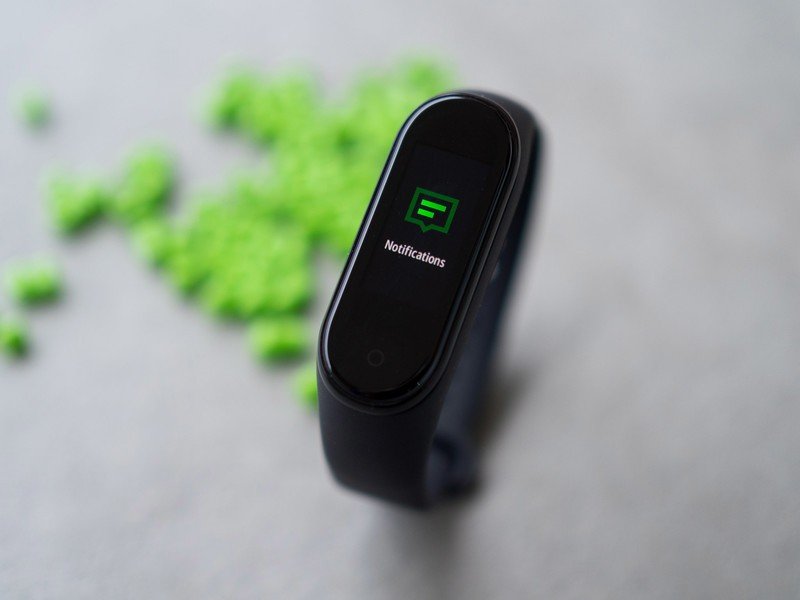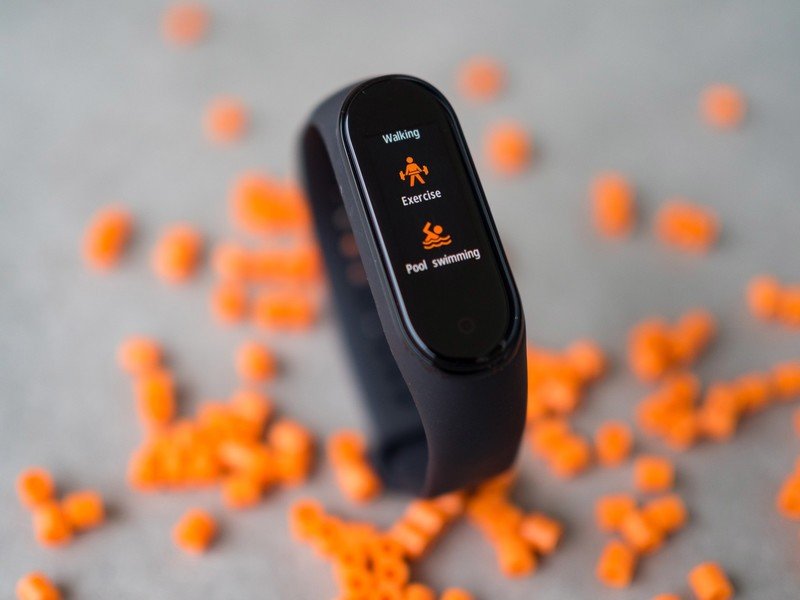Every year for the last three years, Xiaomi has rolled out exciting new features to its Mi Band series. Last year's Mi Band 3 retailed for just $25, offering a heart rate sensor, 5ATM water resistance, and a 0.78-inch OLED panel. The Chinese manufacturer dominates the wearable segment on the back of the Mi Band series, and it's easy to see why — there isn't another budget fitness band that gives you quite as many features.
Xiaomi is continuing that trend with the Mi Band 4. The overall design aesthetic is unchanged, but there are a few key upgrades that make the fitness band stand out: it is the first in the series to feature a color AMOLED screen, and the display itself is larger and is of a higher resolution. The band also has better workout tracking — including swimming — and it has the same weeks-long battery life as its predecessor.
Coming in at under $50, the Mi Band 4 is in a league of its own when talking about value. Here's why Xiaomi's fitness band is the best budget tracker around.
The Good
- AMOLED panel
- 50-meter water resistance
- Automatic heart rate detection
- Weeks-long battery life
- Highly customizable
The Bad
- Charging cradle is easy to lose
Xiaomi Mi Band 4 What I like

At first glance, the Mi Band 4 is nearly indistinguishable from its predecessor. Both have the same design aesthetic, with Xiaomi making a few subtle changes. First up is the lack of an indent at the bottom of the screen that acted as the button for controlling the display. The Mi Band 4 has a smaller button that's located in the same position, but it sits flush with the body.
The key upgrade is the screen itself: the Mi Band 4 sports a 0.95-inch full-color AMOLED display that is absolutely fantastic. The color display gives the Mi Band 4 a leg up over every other fitness band in this segment. I had issues with sunlight legibility on the previous model, but that wasn't an issue on the Mi Band 4. With a maximum brightness of over 400nits, I was able to make out the contents on the screen even under intense glare.
If you're using a Mi Band 2 or Mi Band 3, you should upgrade just for the display alone.
The resolution is also higher at 240 x 120, and the screen has 2.5D curves and an anti-fingerprint coating to prevent smudges. And because of that color screen, you get greater freedom in customizing the watch faces. There's a selection of over 50 options in the Mi Fit app, and switching the watch face is straightforward: just pick the one you like, and hit Sync watch face, following which it will show up on your Mi Band 4. Some of the options look a lot like the watch faces you'd find on Samsung's Galaxy Fit series, and there's enough variety on offer that it should be able to find a watch face to suit your needs.
Even though the display is 33% larger than the Mi Band 3, the Mi Band 4 weighs just 22g. There are a few changes elsewhere: the magnetic connects that hook up to the charging cradle are now located at the back — just below the heart rate sensor. The silicone strap is unchanged from previous versions, and what it lacks in style it makes up for in comfort.



You can swipe up on the screen to see weather information, your daily fitness stats, unread notifications, get a heart rate reading, and manually initiate a workout. The Mi Band 4 has 50-meter water resistance and a 6-axis accelerometer, and Xiaomi has added a host of new workouts to the band's activity tracking. It is now able to track outdoor running, treadmill, cycling, walking, weight training, and swimming. The last option is particularly interesting; you'll be able to set the pool size, and the Mi Band 4 can identify various strokes, and measure the stroke rate, distance, as well as calories burned.
The Mi Band 4 does a much better job with activity tracking, and the ability to track swimming is a welcome addition. The fitness band is also great at mirroring incoming calls and other notifications to your wrist, and you can now set reminders and alarms. There's also the option to control music playback, and you can customize alerts for individual apps. If you don't want to get notifications on your wrist from a specific app, you can turn it off from the settings.



Another thing the Mi Band 4 does well is idle alerts. The band will vibrate if you're inactive for an hour, and you can even choose a custom vibration pattern for the alert. The customizability extends to other features as well: the Mi Band 4 has a heart rate sensor, and you can set the interval for the detection frequency. You can set the band to record your heart rate every minute, or do it at five, ten, and 30-minute intervals. If you set the interval to under 10 minutes, you will be able to create another alert that will trigger if the BPM goes over 100 when you're inactive.
There's also an option to automatically increase the detection frequency during a workout to get more accurate data, and a new feature that locks the band once you take it off your wrist. Honestly, the sheer number of customization options on offer make the Mi Band 4 a stellar product in this category.

Like previous models, the Mi Band 4 relies on Mi Fit to sync fitness data and sleep insights to a phone. The app is also how you change most of the settings on the fitness band, and select new watch faces. Mi Fit picked up a redesign earlier this year, and the interface is much more modern and easier to navigate. The key settings are easily accessible, and you get more customization options than you'll end up using. Best of all, Mi Fit lets you sync to Google Fit, so you can pull all your heart rate and daily activity data from the fitness band directly into Google Fit.
Mi Fit is much more streamlined and easy to use, and it still syncs with Google Fit.
There's now a lift-to-wake option that turns the display on when you raise the band to your face, and because this is Xiaomi you get to customize how sensitive the motion is before the display wakes up. I routinely have issues with this particular feature on the Fitbit Alta HR, but I set it to the sensitive setting on the Mi Band 4 and it has worked flawlessly. As with everything else, you get to set a schedule for the feature.
The Mi Band 4 is great at sleep insights as well, and you can choose for the band to record your heart rate when you're asleep. Continual heart rate monitoring will obviously affect the battery life by a significant margin, and with the automatic heart rate detection enabled during the day, I still got over a week's worth of battery life. The fitness band is able to record light and deep sleep — giving you a score out of 100 — and offer recommendations on how to get a better night's rest, but the insights aren't as detailed as what you get with Fitbit. That said, the Mi Band 4 costs half as much as the Inspire HR.
Battery life, in general, is just as great as the Mi Band 3, and you should easily get two weeks' worth of usage on a full charge.
Xiaomi Mi Band 4 What needs work

Honestly, there's very little that the Mi Band 4 gets wrong. For what you're paying for the fitness band, you're getting stellar value. My main issue with the Mi Band 4 is not the band itself, but the charging cradle: it is just as finicky as earlier models, and it is easy to lose. You have to remove the tracker from the silicone band and attach it to the cradle, and a full charge from zero takes just over two hours. That said, you'll only end up using it a few times every month, so it's not that big a deal.
While the changes to Mi Fit are welcome, it still doesn't have a community feature. You can add other Mi Band users as friends, but there's no way to participate in challenges or set collaborative goals.
Xiaomi Mi Band 4 Bottom line

The Mi Band 4 cements Xiaomi's position as the brand to beat in the budget wearable segment. The color AMOLED screen makes the Mi Band 4 that much more enticing, and you get better sunlight visibility and more options to customize the band to your tastes. The interface isn't laggy, you get a ton of new features and ability to track more workouts, and continual heart rate monitoring.
Combine all that with battery life that's measured in weeks and it's easy to see why the Mi Band 4 is the best budget fitness tracker available today. Mi Fit has also received a much-needed overhaul, and it's easier to view your daily activity and configure the Mi Band 4's settings. The ability to sync data with Google Fit is an added bonus.
The band itself is comfortable to wear all day, and there's a vast ecosystem of third-party options available if you want to switch out the silicone band for a more stylish alternative. Overall, there isn't another wearable that comes close to the Mi Band 4.
4.5 out of 5
The Mi Band 4 retails for just over $45, and while that's $15 more than its predecessor, the addition of the color AMOLED panel more than justify the added cost. You're not going to find another budget fitness band that offers quite the same combination of features and value for money.

The best budget fitness band gets better.
The standout addition on the Mi Band 4 is the full-color AMOLED display: it is vibrant, has excellent contrast, and is easy to see under sunlight. You also get 50-meter water resistance, the ability to track more exercises, two weeks of usage between charges, continuous heart rate monitoring, and better sleep insights. Mi Fit lets you sync all the fitness data directly to Google Fit, and overall there isn't a fitness band for under $100 that comes close to the Mi Band 4.

Harish Jonnalagadda is Android Central's Senior Editor overseeing mobile coverage. In his current role, he leads the site's coverage of Chinese phone brands, networking products, and AV gear. He has been testing phones for over a decade, and has extensive experience in mobile hardware and the global semiconductor industry. Contact him on Twitter at @chunkynerd.

